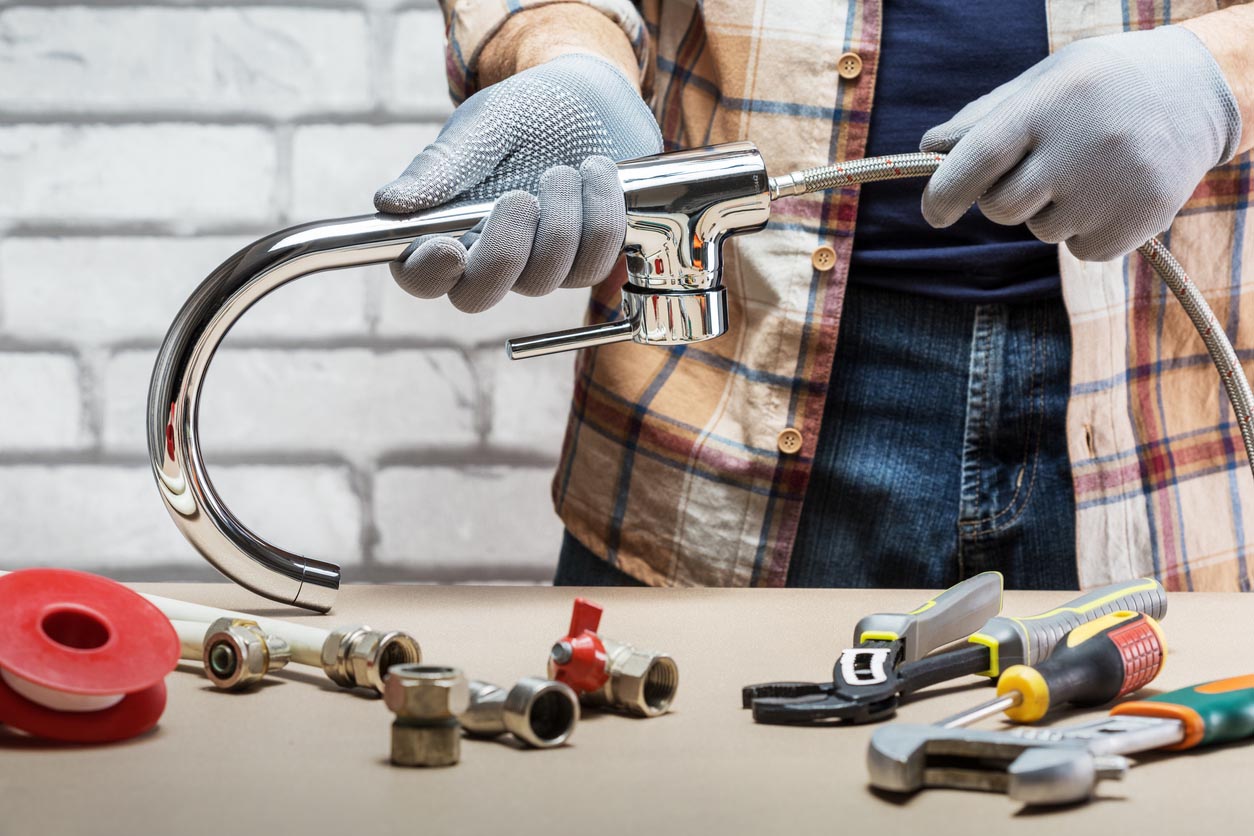

We may earn revenue from the products available on this page and participate in affiliate programs. Learn More ›
Becoming a plumber is a rewarding career path that can lead to a range of interesting opportunities, such as operating a one-man plumbing business, working for established plumbing franchises, or working as a plumbing business owner and managing other industry professionals. However, before starting down this path, it’s necessary for an individual to get the proper plumbing certification for the area. Specific licensing requirements vary from state to state, so it’s important that they check local guidelines.
After acquiring the necessary certifications and working in the field, experienced plumbers may become interested in starting a plumbing business. This can be a great option for dedicated plumbing professionals with a knack for management, but there are still several steps that must be completed before starting a plumbing company. Prospective business owners can use this guide to find out how to start a plumbing business and learn several tips for how to grow a plumbing business.
Before You Begin…

Starting a plumbing LLC (limited liability company) requires knowledge, experience, and planning, so before jumping into a search for “how to start my own LLC,” it’s recommended for plumbers to become more familiar with the costs and responsibilities of a plumbing business owner. According to the Bureau of Labor Statistics (BLS), the national average salary for a plumber is about $60,090, and a plumbing business owner salary can be much higher than that, depending on the current standing of the business.
According to Andrew Miles, CEO at WaterFilterCast.com, “In my time as a plumber, I’ve found that the career offers great job stability since plumbing services are always in demand. I also appreciate the good pay and the opportunity to solve hands-on problems and see the direct results of my work.”
When first starting out, plumbers will need to pay for a business license, registration, plumbing software programs, insurance, uniforms, plumbing equipment, inventory, a website, plumbing business cards, and a work truck or van. These start-up costs will typically range from $6,325 to $8,150, though it may cost more if the business owner chooses to purchase the company vehicle instead of leasing it.
Additionally, the plumbing business owner will be responsible for getting the appropriate insurance. This will ideally include general liability insurance, workers’ compensation insurance, property insurance, and vehicle insurance, as well as business interruption insurance.
Tips for How to Start a Plumbing Business
- Properly organize every part of the business, including managing invoices, work orders, and payroll.
- Hire a reliable crew of plumbing and customer service professionals to help support the company.
- Be on the lookout for ways to cut overhead costs without sacrificing quality.
- Show appreciation to hard-working staff through appropriate pay and benefits, regular raises, and financial bonuses.
STEP 1: Complete all necessary training, either through a trade school or an apprenticeship, to earn your plumbing license.
A plumbing business owner needs to have the appropriate plumbing licenses to be able to perform plumbing work on their own. Individuals can start this process by becoming an apprentice plumber, either by attending a local trade school, taking one of the best online plumbing courses, or finding a master plumber who is looking to take on an apprentice. Apprentice plumbers cannot work unsupervised, which means they cannot start their own business. First, they will need to work for several years as an apprentice to further their skills, then take the journeyman plumber licensing test.
A journeyman plumber has a higher salary than an apprentice plumber, and they can work independently without supervision. At this point, the plumber can continue to work for an established company or they can choose to build their own plumbing business. However, it may be more beneficial for them to pursue a master plumber license before starting a plumbing company. This is the highest level of licensure, which allows the holder to train and supervise both journeyman and apprentice plumbers.
Beyond the standard plumber licenses, the business owner will need to consider whether they will be limited to residential plumbing jobs or if they will be taking on commercial, industrial, and institutional contracts. Acquiring a plumbing contractor license is essential for anyone who plans to bid on and oversee large plumbing projects outside of standard residential work.
Additionally, some plumbing jobs may require speciality certifications that fall outside of typical plumber licensing. Some examples of speciality certifications include a gas fitters license to work with gas water heaters, a confined space certification for working in pits and chambers, or even a certification indicating that the company follows green plumbing practices.

STEP 2: Determine your business goals and write a comprehensive business plan that covers short- and long-term goals, marketing strategies, growth opportunities, and the business’s financial outlook.
Starting a business is a serious endeavor that should not be undertaken lightly. Before diving into equipment sourcing, tool purchases, and employee hiring processes, it’s necessary for an individual to consider the goals for the business in order to put together a cohesive business plan. This will help keep the company on a path toward success, though it’s also a good idea to research competitors and look into potential marketing strategies that have worked for other businesses in the area. Some new businesses will rely on the guidance of a plumber business consulting company to get started, but this isn’t strictly necessary.
Entrepreneurs will want to take some time to evaluate current market trends and growth opportunities in the community. For instance, if there are several companies that cater to water heater repairs and servicing, it may be best for a new business to focus on a different specialty niche, such as irrigation system installation. Similarly, new companies can attract more attention with high-quality service, including building a comprehensive website that provides potential customers with easily accessible information about home plumbing systems, plumbing services, pricing, and any warranties or guarantees the company offers.
“I have found that plumbing jobs come in waves,” explains Bill Bruininga, co-owner of Billy’s Plumbing & Rooter in the Los Angeles area. “This means sewers, new construction, and service calls are all great, but if you sit just waiting for sewer calls, you will be waiting while other work is available. Be open to multiple specialties. Know your workers and their abilities. The first years should be spent developing how you want everything done. Don’t allow others to dictate your future.”
This research and initial marketing forethought will help aspiring business owners put together a realistic plumbing business plan. The plan will need to include an executive summary, market research, a competitive analysis, business structure and operations, and marketing and sales strategies, as well as financial projections for the first 3 to 5 years.
- Executive summaries are used to record a concise summary of the complete business plan, which is often necessary to show potential investors and banks.
- Market research will help the company understand customer needs and assess market viability in the area.
- Competitive analysis is essential for researching other plumbing companies in the area to analyze their strengths and weaknesses.
- Business structure and operations outlines the legal structure of the business and identifies the operational factors, such as the staffing needs, equipment needs, and any certifications or licenses the business requires.
- Marketing and sales strategies are used to come up with innovative ways to attract customer attention, such as promotional sales, pricing strategies, and service packages. A plumbing marketing agency may be able to help if marketing isn’t a strong suit for the business owner.
- Financial projections for the first 3 to 5 years are crucial for gaining an understanding of the potential profitability of the business. Financial projections will need to include projected income statements, balance sheets, and cash flow statements, as well as start-up costs, and any funding requirements.
STEP 3: Research financing options, which could include a loan from a financial institution or private lender, funding from a venture capital firm, or a grant or loan from the government.
There are many factors involved with starting a plumbing business, such as getting the proper licensing and insurance to operate the company or purchasing a work van or work truck to travel between appointments. Most steps in the process will require some type of financial investment, whether it is to pay for trade school, purchase new tools, or hire workers to expand the company, so the plumbing business owner will likely need to look into potential financing options.
Entrepreneurs will want to make sure they have a well-thought-out business plan compiled in an executive summary before seeking financial support from any financial institutions, private lenders, or venture capital firms. The executive summary should include a brief breakdown of the market research, competitive analysis, business structure, operational requirements, marketing strategies, and financial projections for the next 3 to 5 years.
With a prepared business plan, the plumbing business owner can begin looking for financial support from a variety of investment sources, but it’s important for them to set up a bank account for the business beforehand to ensure that any financial investment the company receives remains separate from the owner’s private assets. This method of organizing the company finances lends more credibility to the business and helps to protect the business owner from potential liabilities in the future.
- Government funding can be a good choice for a start-up business. The government will often offer funding programs such as small loans and investment capital.
- Business loans or lines of credit can be applied for at a bank or from a trusted online lender. Some business owners may also feel comfortable approaching a family member or a friend for a loan, though this isn’t recommended as it can create a strain on the relationship.
- Business credit cards can help keep track of business expenses, such as fuel purchases for the company vehicle.
- Business grants may also be available, though there may be other business owners competing for the same grant money.

STEP 4: Register your business and get the appropriate insurance coverage.
Once the company has financial backing, it’s time for the business owner to select a company name and register the business. They’ll want to take time to come up with a company name that is easy to remember, gets to the point about what the business offers, and draws customers to the business. Ideally, the company name will be short enough to fit on business cards, company uniforms, documents, and vehicle decals.
After deciding on a suitable name, the owner will need to determine the business structure. Common options include a sole proprietorship, a partnership, a corporation, or a limited liability company (LLC). If the business owner isn’t sure about which structure would best suit the business plan, they may want to speak with a business adviser or an attorney to get professional advice.
“When I wanted to start my plumbing business, I first had to obtain a business license and insurance,” says Miles. The business owner will need to register the company name with the appropriate state agency, then work to obtain a business license and an employer identification number (EIN), which is necessary for tax purposes when hiring employees. Additionally, the business owner will have to get insurance coverage for the company, the property, the work vehicle, and the workers. Getting quotes from the best small business insurance companies such as Next Insurance or Thimble can give business owners an idea what they should expect to pay.
- General liability insurance is required to do business in almost all states. The purpose of the insurance is to cover the business in the event of injury or property damage claims.
- Workers’ compensation insurance is essential for any company that plans to hire employees. This insurance will help alleviate the costs of worker injuries, covering medical bills, lost wages, and rehabilitation.
- Property insurance is intended to protect the physical building where the business is located and any property inside the building.
- Commercial auto insurance will help to cover vehicle repairs and replacement in the event of theft or an accident. It also includes liability coverage to protect the business if the driver of the vehicle causes an accident resulting in injury or property damage to a third party.
- Business interruption insurance supplements lost income if the business needs to stop operations temporarily for any reason.
STEP 5: Purchase necessary business equipment, such as tools, chemicals, parts, and a business vehicle.
“I also needed to purchase all the necessary tools and equipment for plumbing repair and set up an accounting and invoicing system,” explains Miles. Plumbers use a wide variety of tools and equipment to conduct day-to-day business, so a new plumbing business will need to invest in all necessary equipment, including tools, chemicals, inventory parts, and a work truck or van. This step will typically be the biggest financial investment to get the business started, so the owner will want to be prepared to spend a significant amount to get high-quality tools, parts, and materials.
Purchasing low-quality tools and equipment can be a useful method for starting the business on a budget, but in many cases these low-quality products are better suited for infrequent DIY jobs. It’s unlikely that low-quality tools will be able to hold up for long when they are being used on a daily basis in a professional plumbing environment. With this in mind, it’s better for the business owner to invest more money up front in quality tools, since having a tool break in the middle of a job can give the company a reputation for being unprofessional.
The business owner will need to purchase tools and equipment for the business location, such as shelving, containers, and other organizational products. They will also need to invest in the necessary tools and equipment for the plumbing truck setup. Business owners can consider the following list of common plumbing tools when purchasing equipment for a startup plumbing company.
- Pipe cutters are used to cut through copper, lead, galvanized iron, and composite pipes.
- Pipe wrenches grab and hold smooth plumbing pipes, as well as gripping and turning unions, couplings, and other plumbing fittings.
- Plungers use applied pressure to dislodge clogs.
- Drain snakes physically break up or dislodge clogs after being fed into a small drain. These tools are usually manually operated and limited in length.
- Drain augers are intended for removing large clogs deep inside the plumbing system with a motorized snake that enters through the nearest opening in the drain line.
- Inspection cameras allow plumbers to see inside drain lines, behind walls, up in the ceilings, or under floors.
- Pipe and tubing benders help to bend and shape piping for custom installations.
- Pipe threaders cut pipe threads into bare piping so that couplings, unions, or other threaded fittings can attach to the pipe.
- Acetylene torches are commonly used for soldering, though some plumbers may prefer a MAPP gas torch, which uses methylacetylene-propadiene propane as fuel and can reach higher temperatures than other types of torches.
- Flame shields help protect wood, tile, drywall, insulation, and any other vulnerable materials from heat and flame during soldering.
- Fire extinguishers are necessary for ongoing safety and protection while a blow torch is being used.
- Hacksaws can be used to cut through pipes and other materials.
STEP 6: Establish a reliable accounting system.
Any business can fail if the business owner does not remain focused on the income and expenses of the company. A plumbing business is no different. The owner will need to balance the costs of tools, materials, salaries, property rental, vehicle repairs, insurance costs, and more, while ensuring that the business is bringing in enough income. There are accounting software tools that are designed for company use to help organize and streamline the accounting process. This can be an effective way for business owners to establish a reliable accounting system for the company without hiring any additional employees.
However, the larger the business grows, the more costs and expenditures there will be for the owner to balance. With this in mind, it’s a good idea for the business to have an accounting professional on staff to help manage the finances for the company. This does not mean, however, that the business owner can step back from the accounting side of the business. It’s important for a business owner to always be aware of the incoming revenue, the outgoing costs, and the financial projections of the company.
Entrepreneurs will want to ensure they put aside enough of the business’s earnings to cover marketing costs, employee salaries, inventory purchasing, rent, utility bills, insurance costs, and income tax. It’s always better for a business to have more than enough saved than to fall short when an important bill comes due.
Plumbing business owners may also consider investing in the best plumbing software (such as Jobber) to help improve the efficiency of day-to-day business operations. These programs can handle scheduling, dispatching, invoicing, and more, while the best home design software may be beneficial if it allows the user to design plumbing systems in the home. Some of the best plumbing software can also integrate with accounting programs, such as QuickBooks, though it depends on the individual program.

STEP 7: Determine which services you’ll offer, and create a pricing structure.
Plumbers are capable of working on a wide range of systems, so when building a new plumbing company, it’s important for the owner to consider the type of service the company will offer. Some plumbing companies limit the service to residential plumbing, choosing to focus on water-using appliances, repairing or replacing plumbing lines, and residential drain system maintenance. Other companies refuse to take on any residential work, instead focusing on large industrial, commercial, or institutional plumbing systems, such as those in factories, malls, schools, or hospitals.
Neither option is easier, so it often comes down to the personal preference of the business owner. This doesn’t mean that the business must be limited to residential plumbing. As the plumbing company grows, the business owner can look into taking commercial or industrial plumbing contracts and hiring plumbers with substantial experience in these fields. However, if the business owner did their apprenticeship primarily in residential plumbing, then it’s a better idea to start the business in residential plumbing, rather than jumping into a portion of the industry that isn’t as familiar.
After deciding between residential or commercial plumbing, the business owner will want to consider the specific services they will offer, such as water heater installation, fixture installation, drain cleaning, water filtration system maintenance, backflow testing and repair, slab leak detection, or trenchless sewer repair. A company does not need to offer every type of plumbing service. In fact, it’s better for a business owner to research existing companies in the area to determine what services they offer, then use this information to fill any gaps in the market. For instance, if most companies offer water heater installation and maintenance, but only one or two mention backflow testing and repair, then it can be beneficial for the business owner to add backflow testing and repair to their company’s service offerings.
Next, the business owner will need to put together a pricing structure. They can start by calculating the hourly base rate and the overhead costs, then factor in the planned profit margin to calculate markup. Then, they’ll need to figure out the total labor costs and estimate the cost of materials for the project, then add these figures together to come up with suitable price estimates for the various services the company plans to offer. Business owners may want to consider creating service packages that offer customers a combination of services at a discounted rate, such as a maintenance package that includes regular inspections, water heater maintenance, and drain cleaning.
STEP 8: Create a website, Google Business Profile, and social media profiles for your business.
It’s difficult for a business to exist in the modern world without an online presence, so when building a new plumbing business, it’s essential for the owner to create a company website. It’s also a good idea to make a Google Business Profile, as well as business profiles for various social media platforms. This will help direct potential customers to the new plumbing company and hopefully drum up some business. Additionally, an online presence makes it easier for wary customers to research the company, check past reviews, and find the company information to contact the business.
Business owners will want to start by building a company website. The website will need to have a brief plumbing company bio that gives some background on the business, the business owner, and any notable licenses or certifications. Typically, customers will also want to see hours of operation, a list of offered plumbing services, pricing, and contact information so that they can call or email to book appointments or ask questions. Another great idea is to have a database of informative articles to educate customers on plumbing components and plumbing systems.
Next, the business owner will want to create a Google Business Profile. This profile needs to contain work hours, location, and company information so that it’s easy for customers to find or contact the business. Additionally, they’ll want to spend some time building social media profiles on platforms such as Instagram, Facebook, X (formerly known as Twitter), or YouTube. These profiles can be used to advertise the business, answer questions, address concerns, or even to post pictures of a particularly impressive job that was recently completed, assuming the customer has given permission.
Email marketing and communication are also important for the ongoing success of the business. Many people prefer to have a record of a conversation, especially when they are hiring new general contractors or plumbers. Instead of forcing customers to call in, the business owner can make appointment booking available through email.

STEP 9: Hire qualified and experienced technicians to help grow your business
It’s possible to have a one-person plumbing business. In fact, it’s a great way to initially get started in the industry. A single person can hire themselves out for a small amount of work, gradually building a name and saving for future investments. However, when it is time to expand the company, it’s important for the business owner to put a heavy emphasis on finding skilled, experienced, and overall reliable workers. A company can have the top plumbing expert in the area, but if they are rarely available for work, then the investment in the individual has diminishing returns and can even make the company look bad.
Ideally, the plumbing business owner will have their master plumber license. This alone can be an attractive reason for plumbing apprentices to apply to the company. Hiring apprentices is a great way for a plumbing business to take on more work without paying the higher salary of a journeyman or master plumber. Additionally, apprentices are an investment for the business. If they are trained properly, they can be great assets in the future once they have passed the journeyman plumber licensing test. Though, the drawback is that an apprentice will require direct supervision for the duration of their apprenticeship.
Business owners can avoid becoming overworked by ensuring that there are enough qualified and experienced technicians on staff. This will also include customer service staff and accounting staff to help manage the business. When hiring a new employee, the business owner will need to decide on the position that needs to be filled, then write a job description that outlines the responsibilities, benefits, and wages for the position. Some companies will withhold advertising the salary to encourage more applications, but this can lead to wage disagreements and wasting time in dead-end interviews. It’s better to be up front about pay rates when advertising on the company website, online job boards, and social media.
After coming up with a list of potential candidates, the business owner can meet with them one on one to ask a series of interview questions. They’ll want to relate the questions to the position that the business is looking to fill. Plumbers will need to be able to provide proof that they hold a plumbing license and to answer a series of technical questions related to plumbing systems.
“Running a one-person plumbing business can help keep overhead costs low when first starting the company. Once the company is busy enough, hire additional staff to increase and diversify the service offerings of the business.”
—Timothy Dale, BobVila.com contributor and former Industrial, Commercial, and Institutional (ICI) Plumbing Project Manager
STEP 10: Build a customer base and work on building up your company’s reputation to attract additional customers.
Putting all the effort into building a company only really pays off once the company starts to succeed. Before that point, the business owner may struggle to pull in new customers, meet payments, and keep up with advertising efforts. In order to succeed as a new company, the business needs to build up a base of repeat customers while finding ways to attract attention from new customers.
The most direct way to get customers is through word of mouth, so it’s essential for new customers to feel happy and satisfied with the service they have received. Friends and family members can also help spread the word about the new business, but an honest review from an individual who is not connected to the owner or any employees holds more merit than a glowing commendation by a close friend or partner. For this reason, it’s recommended for the business to post customer reviews on its website to provide an honest assessment of what the company has to offer.
Website and search engine optimization can help to increase the visibility of the company website on search engines. Similarly, companies can use pay-per-click (PPC) advertising platforms to display ads and marketing campaigns. The business owner or customer service staff can reach out through social media platforms to engage with customers or build an email list to send out regular newsletters with informative updates and home plumbing DIYs.
Another great way for the business owner to improve the company’s reputation is to get involved in local events, such as sponsoring local sports teams, joining community organizations, or participating in charity initiatives. New plumbing businesses can opt to use a referral program to encourage word-of-mouth marketing by offering incentives or discounts for successful referrals. Business owners will also want to remember the importance of being seen. Applying logos and company information on plumbing vans or trucks can help promote the business wherever the vehicles go.
STEP 11: Keep up to date on licensing and certifications.
Licensing, certifications, and insurance coverage requirements can vary depending on the location and the type of work. They can even change over time, so it’s necessary for business owners to keep up to date on the operational requirements for the business. The plumbing business owner will want to regularly update any licenses or certifications as needed, while investing time into learning about new techniques and any changes to the industry.
Planning for the long term is a crucial step for ensuring the ongoing success of the plumbing business. Plumbing business owners will want to take a proactive approach to business management with continuous learning efforts and frequent training to ensure that their customers are getting the highest quality work available. They’ll want to remember that customer needs are constantly evolving, so what may be acceptable right now may not be in the future.
Business owners can also consider networking with other plumbers and plumbing business owners to learn from their success stories, as well as their failures. They’ll want to regularly evaluate and adjust the company business strategies, while also identifying areas for improvements or changes that can help them adapt to the market. Business owners can further their own education by attending industry conferences, researching new technologies, and by taking on new apprentices. After all, there is much that can be learned by teaching.
Similarly, effective financial management is key to the success of the business. It’s important for business owners to maintain accurate records, monitor cash flow and stick to a budget to ensure financial stability and profitability for the foreseeable future. They may also want to consider taking a course to fill in any gaps in their knowledge base, such as an accounting course or management course.
There is more to building a successful plumbing business than a catchy name. It requires careful planning, strategic decision-making, and dedication. When starting a plumbing business, the owner will need to ensure they have the proper licenses and certifications, as well as the appropriate insurance coverage for the business, property, company vehicle, and workers. It’s also necessary for the business owner to put together a solid business plan, including market research, a competitive analysis, business structure and operations, and marketing and sales strategies, as well as financial projections for the first 3 to 5 years.
Next, the business owner must consider where to get financial backing for this endeavor and determine the services the business will offer. Only then can they build an online presence, hire additional employees, and begin growing the business toward success. A business owner who sticks to this plan can expect to lay a strong foundation for the future and differentiate the company in the current market to build a thriving plumbing business.
Sources: Bureau of Labor Statistics, Jobber
